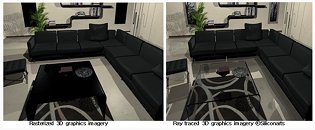- Joined
- Dec 6, 2011
- Messages
- 4,784 (1.00/day)
- Location
- Still on the East Side
Siliconarts Inc., a Korean tech startup, developed RayCore, the real-time ray tracing graphics processor (GPU) for the first time in graphics hardware history. RayCore is the next-generation GPU that is used in rendering high-quality 3D graphics whose graphics performance surpasses that of rasterization GPU approach.
Mostly utilized in Hollywood studios in creating huge contents such as "Toy Story" and "Avatar," realistic effects are the key to differentiating the features of ray tracing technology compared to a rasterization approach. However, ray tracing was only implemented using software due to the limitations to process exponential calculations, to equip with highly expensive series of rendering gears and to process and the wait for significantly longer rendering times. In addition, it was not even implemented on a real-time basis.

RayCore, developed by Siliconarts, is a hardware that has overcome the limitations of the existing ray tracing approach, applying all of the benefits of ray tracing to its product that can render cinema-quality 3D graphics effects on real-time basis.
Particularly, RayCore is designed to consume the industry's lowest power level in order to implement both User Interface and User Experience on mobile platforms such as smartphones; it is expected that a significant impact is inevitable to the mobile game space. In other words, UI/UX as well as mobile games created based on these high-quality 3D effects will be made possible. A senior official of Siliconarts mentioned that ray tracing technology-enabled smartphones will be introduced soon, as the company already completed its license agreement with Company A to supply RayCore GPU IP.
"The key feature of this product is that ray tracing, which was considered impossible to implement using hardware, is now available not only on PCs and servers, but also in diverse devices such as smartphones and smart TVs. None of the global GPU companies have successfully implemented ray tracing on a real-time basis and their technology level is still trivial. It is almost impossible to implement," said Hyung Min Yoon, the CEO of Siliconarts.
You can witness the powerful implementation of exquisite 3D graphics using RayCore as the company will be demonstrating its products at i-SEDEX2012 from October 9 - October 11 at #2570, Hall 2, KINTEX, Goyang-si, Gyunggi-do, Korea.
View at TechPowerUp Main Site
Mostly utilized in Hollywood studios in creating huge contents such as "Toy Story" and "Avatar," realistic effects are the key to differentiating the features of ray tracing technology compared to a rasterization approach. However, ray tracing was only implemented using software due to the limitations to process exponential calculations, to equip with highly expensive series of rendering gears and to process and the wait for significantly longer rendering times. In addition, it was not even implemented on a real-time basis.
RayCore, developed by Siliconarts, is a hardware that has overcome the limitations of the existing ray tracing approach, applying all of the benefits of ray tracing to its product that can render cinema-quality 3D graphics effects on real-time basis.
Particularly, RayCore is designed to consume the industry's lowest power level in order to implement both User Interface and User Experience on mobile platforms such as smartphones; it is expected that a significant impact is inevitable to the mobile game space. In other words, UI/UX as well as mobile games created based on these high-quality 3D effects will be made possible. A senior official of Siliconarts mentioned that ray tracing technology-enabled smartphones will be introduced soon, as the company already completed its license agreement with Company A to supply RayCore GPU IP.
"The key feature of this product is that ray tracing, which was considered impossible to implement using hardware, is now available not only on PCs and servers, but also in diverse devices such as smartphones and smart TVs. None of the global GPU companies have successfully implemented ray tracing on a real-time basis and their technology level is still trivial. It is almost impossible to implement," said Hyung Min Yoon, the CEO of Siliconarts.
You can witness the powerful implementation of exquisite 3D graphics using RayCore as the company will be demonstrating its products at i-SEDEX2012 from October 9 - October 11 at #2570, Hall 2, KINTEX, Goyang-si, Gyunggi-do, Korea.
View at TechPowerUp Main Site
Last edited by a moderator:







